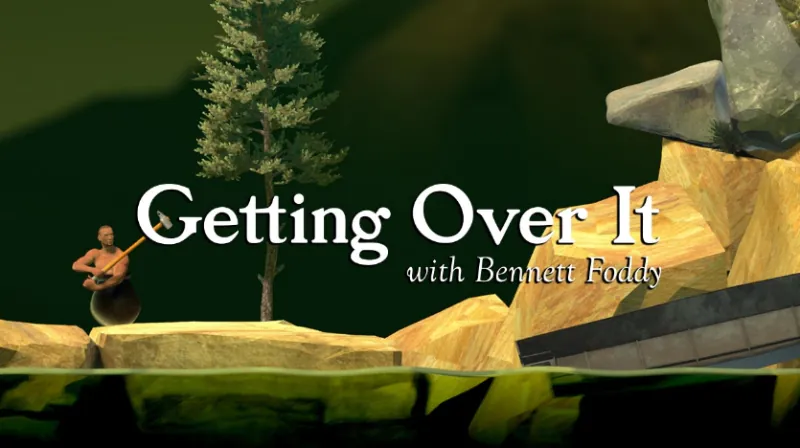Getting Over It vs. I Wanna Be The Guy
Introduction
Overview of Getting Over It
Getting Over It is uniquely designed game in which players control a character in a cauldron who tries to climb over a mountain of objects using only a long hammer. The concept is simple, and yet its execution provides an unparalleled gaming experience intertwined with philosophical notions, creating an atmosphere that’s both intriguing and frustrating.


Overview of I Wanna Be The Guy
Predating Getting Over It, I Wanna Be The Guy The Game, popularly known as IWBTG, offers an equally grueling regimen. Here, players navigate a 2D world filled with overly scattered platforms, perilous traps, and sly tributes to classic video games. Despite its challenging nature, it’s a game that continues to be adored by a cluster of gamers worldwide.
An in-depth comparison: Getting Over It vs. I Wanna Be The Guy
Gameplay comparison
On the surface level, both games have entirely dissimilar gameplay. Getting Over is a unique physics-based climbing game performed in a 2D side-scrolling perspective. The controls demand precision and an understanding of momentum. If you want to learn more about its gameplay, you can refer to the Getting Over It strategy. On the other hand, “I Wanna Be The Guy” draws on traditional platformers to present a hazardous terrain that punishes incautious actions and rewards memorization and patience.
Graphics and technical aspects comparison
Getting Over It embraces a more realistic and contemporary design. Its unconventionally artistic visuals simulate rendered objects and structures that appear somewhat lifelike. In contrast, I Wanna Be The Guy refers to the retro gaming era with its pixelated graphics, rudimentary effects, and familiar aesthetics.
Comparing the difficulty level
Each game demonstrates a distinctive approach to difficulty. GOI relies heavily on its unpredictable physics system, which can turn a small mistake into a crippling setback. On the other hand, IWBTG flips platforming norms; it keeps players vigilant with seemingly innocent but deadly objects and unpredictable death traps. Both games require copious amounts of patience but impose challenges in quite disparate ways.
Replayability
The replayability of both games arises from the sheer challenge they pose. “Getting Over It,” with its randomness governed by the player’s control and the laws of physics, ensures every climb feels slightly different from the previous one. With IWBTG, the infamy of its difficulty pushes players to beat the game, meticulously learning from their past mistakes, which fuels its replayability.
Analysis of player reviews for the two games
Getting Over It and IWBTG attract gamers who pursue challenging experiences and possess high tolerance levels. Overwhelmingly, players mention their immense satisfaction after conquering a challenging segment in their reviews-proof of the delicate balance both games maintain between frustration and reward. And if you want to learn more about the first game, you can refer to the Getting Over It guide.
Final words
GOI and IWBTG are prime examples of challenging games that use adversity as their main draw, whether it’s the physics-defying climbs or the brutal 2D platforming, the perseverance in the face of repeated failures, and the eventual achievement that provides a sense of fulfillment often unmatched in video games. They may not be the games for every player, but for those who are in for testing their mettle, they are worth every metaphorical and literal uphill battle.
Recent Posts
- Panda Helper Blog
Top 5 Design (UI/UX) Agencies for Early-Stage AI Startups to Watch in 2025
The boom in Artificial Intelligence has created a unique challenge: we have incredible backend technology…
- Panda Helper Blog
Stop Hiring for Language: Automate 35+ Languages with Multilingual TTS API
When it is about global expansion, language is always the bottleneck. The classic solution of…
- Panda Helper Blog
Privacy & Security Comparison: Encryption, Logging Policies, and Jurisdiction Implications
Privacy is something we all want (or crave) when we use the internet. But is…
- Panda Helper Blog
How to Find Educational & Study Apps for Free — Even If They’re Paid on App Store
You shouldn’t have to hunt for learning aids as if they’re rare treasures. Yet many…
- Panda Helper Blog
Inside the 2025 Used Car Market: Auctions Reveal What Keeps Prices Rising
A Shift That Redefined the Car Market The used car market changed dramatically after 2021…
- Panda Helper Blog
Top Software Conflicts That Make Your MacBook Internet Slow — And How to Stop Them
In many cases, this begins when applications are competing for the same network or system…